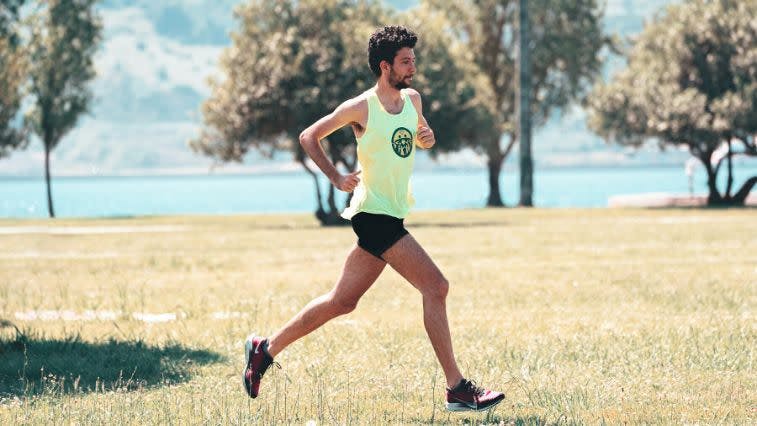Your Foolproof Plan to Build Running Endurance From a Running Coach
Our content strives to support, inform, and motivate you to meet your health goals. We want to be your trusted source of expert- and science-backed info dispensed in simple, actionable ways. Read our Editorial Guidelines.
Back in high school, I remember preparing for my first year of field hockey pre-season and
run for up to three miles all at once?
Well, somehow I managed, and it turned out that I was a fairly decent distance runner. But, this is a common viewpoint for many new runners. They feel like running is hard and they’ll never be able to run a full mile or longer.
With some patience and the right mindset, it’s absolutely possible to build your running endurance.
As a running coach, I regularly work with runners who want to build their endurance. While it may sound daunting, this is one of my favorite parts about coaching because it’s so empowering when runners hit new distance milestones for the first time.
Most of the time my runners are surprised by how their endurance can improve relatively quickly. By tailoring proven strategies that increase endurance to suit your individual needs, you can run farther without falling apart.
Why You Need Running Endurance

Before I explain exactly how to build running endurance, let’s talk about what that actually means.
Endurance includes both muscular and cardiorespiratory endurance. Muscular endurance involves your muscles being able to exert force for a certain amount of time, while cardiorespiratory endurance is the ability of your lungs and heart to perform an activity over a long period of time.
If you have good endurance, you can exercise for a moderate or long amount of time before getting tired. Stamina is similar, but is more specifically related to the mental and physical ability to sustain an activity at near maximum capacity.
If you’re a runner looking to cover longer distances, then you want to focus on building your running endurance.
How to Build Running Endurance
When working toward building running endurance, the first thing to keep in mind is that there’s no set timeline for how long it will take to be able to run a certain distance or for a certain amount of time. By taking it slow and listening to your body, you’ll be able to make sustainable gains in your fitness.
Focus on time on your feet
Rather than trying to run a certain amount of miles, focus on how long you can run for. This will allow you to build from running for 20 minutes to 30 minutes to eventually an hour or longer.
Allow yourself to take walk breaks, which count toward that time on your feet. You’ll be more successful at building your endurance if you run for 30 minutes with walk breaks than if you can only run for 20 minutes straight without stopping to walk.
Include recovery days and cutback weeks
As you’re building your endurance, it’s important to focus on recovery. Make sure to take rest days, recovery days (when you don’t run but might move in another way), and cutback weeks (a drop in total weekly volume, distance, or time spent running).
Proper recovery allows your body to come back stronger so you can continue building in your next workout.
Fuel properly
As you begin to run for longer periods of time, it becomes increasingly more important to fuel well. Try to eat something, even a small snack, before a run. As your runs stretch past 60–90 minutes, it’s a good idea to take fuel while you’re running. There are many gels available that are convenient to carry with you, or you can try whole foods like raisins or an applesauce pouch. Make sure to stay hydrated with plenty of water and even electrolytes, depending on how long you run and what weather conditions are like.
Slow down
As you’re working to build running endurance, make sure to slow down! This will allow you to run longer without getting as tired. It may feel awkward at first, but there are many benefits to slowing down on your runs. You’ll be able to not only run longer without feeling tired, but also recover faster and have a reduced risk of injury. Train your brain
For many runners, the hardest part about building endurance is the mental aspect. It can take some time to get used to running longer. You can try running with friends or listening to music/podcasts to make the time go by faster.
Or you can work on embracing the discomfort to train your brain to endure the longer runs. Oftentimes you’ll find that you can eventually zone out on a long run and the time goes by much faster.
Focus on your form and breathing
By using good running form, your muscles will be able to endure longer periods of running. Strength training a few days a week can help ensure that the muscles you need for running are strong and activated.
If you feel like you’re getting out of breath easily on your runs, try to slow your breathing and take deeper breaths by breathing in through your nose and out through your mouth. You don’t need to maintain this for your entire run, but doing this every few minutes can regulate your breath — and may make your breathing more efficient throughout the run. (If you really can’t slow your breathing, try slowing down or taking a walk break.)
Follow a good training plan

It’s important to put your training into place by following a structured, progressive training plan like the one below. A few things I like to include when training runners to build endurance are rest days, cut back weeks, and a slow progression to increase mileage or time on feet.
Your 8-Week Training Plan to Build Running Endurance
Monday | Tuesday | Wednesday | Thursday | Friday | Saturday | Sunday |
Rest day | 20-minute easy run/walk | Cross training/strength training | 20-minute easy run/walk | Rest day | 30-minute easy run/walk | Cross training/strength training |
Rest day | 25-minute easy run/walk | Cross training/strength training | 25-minute easy run/walk | Rest day | 35-minute easy run/walk | Cross training/strength training |
Rest day | 30-minute easy run/walk | Cross training/strength training | 30-minute easy run/walk | Rest day | 40-minute easy run/walk | Cross training/strength training |
Rest day | 20-minute easy run (with walk breaks if needed) | Cross training/strength training | 20-minute easy run (with walk breaks if needed) | Rest day | 30-minute easy run (with walk breaks if needed) | Cross training/strength training |
Rest day | 25-minute easy run (with walk breaks if needed) | Cross training/strength training | 25-minute easy run (with walk breaks if needed) | Rest day | 35-minute easy run (with walk breaks if needed) | Cross training/strength training |
Rest day | 30-minute easy run (with walk breaks if needed) | Cross training/strength training | 30-minute easy run (with walk breaks if needed) | Rest day | 40-minute easy run (with walk breaks if needed) | Cross training/strength training |
Rest day | 35-minute easy run (with walk breaks if needed) | Cross training/strength training | 35-minute easy run (with walk breaks if needed) | Rest day | 45-minute easy run (with walk breaks if needed) | Cross training/strength training |
Rest day | 25-minute easy run | Cross training/strength training | 25-minute easy run | Rest day | 35-minute easy run | Cross training/strength training |
You can see from this training plan how the runs gradually increase, but every fourth week is a cutback week, when the time running is reduced. This type of plan can be continued to reach your endurance goals.
I have used this type of plan every time I have come back to running after time off. Whether I was returning to running postpartum or after an injury, my endurance always comes back faster than I expect. However, patience is key because every timeline is different!
Running more miles and running well for longer can be tough to do on your own. If you’d like some help, sign up for a free consultation with a certified personal trainer who specializes in running.